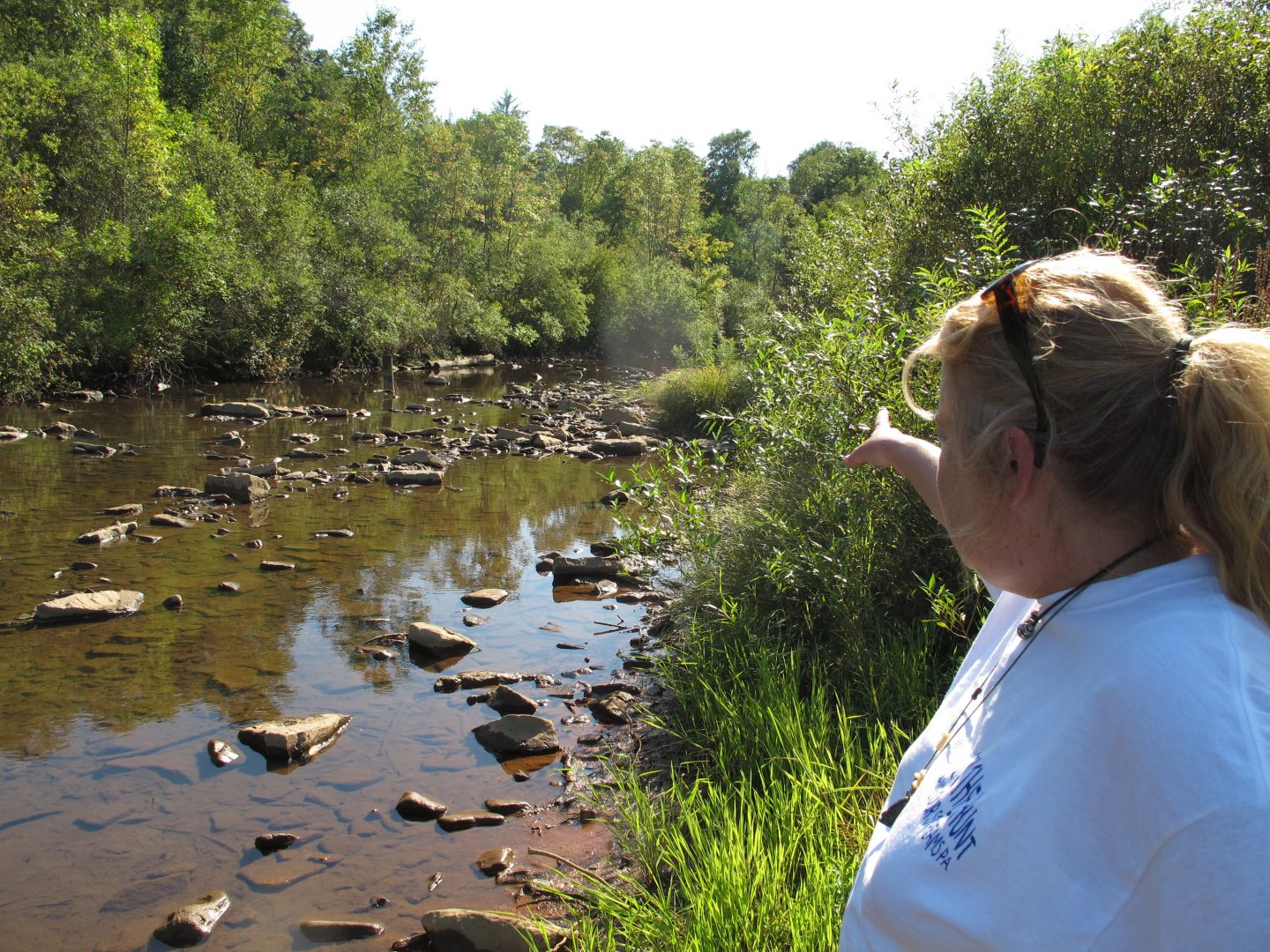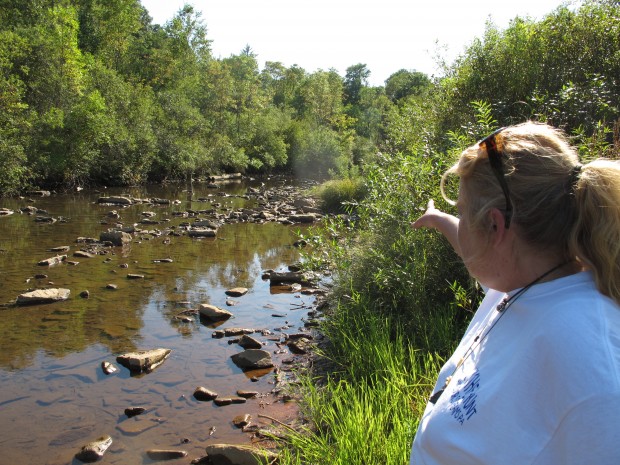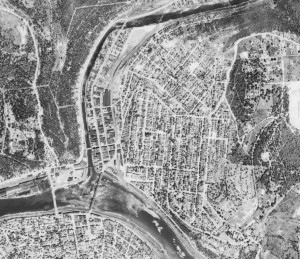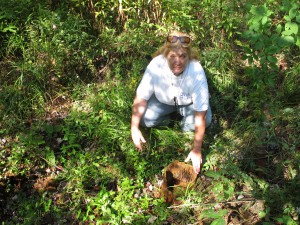
Laurie Barr points to an abandoned well located in the middle of a McKean County stream
Scott Detrow / StateImpact Pennsylvania


Laurie Barr points to an abandoned well located in the middle of a McKean County stream
Scott Detrow / StateImpact Pennsylvania

Scott Detrow / StateImpact Pennsylvania
Laurie Barr points to an abandoned well located in the middle of a McKean County stream

Scott Detrow / StateImpact Pennsylvania
Laurie Barr points to an abandoned well located in the middle of a McKean County stream
If you want to find evidence of Pennsylvania’s long history of oil and gas drilling, a good place to start is in Laurie Barr’s back yard. Behind Barr’s house, a few rusty pipes stick out of the ground, abandoned entry points to wells drilled long ago.
Until recently, Barr had no inkling that abandoned wells could be dangerous. She decorated one of the pipes in her backyard with a bird feeder. Then Barr heard about a how a house in Bradford, McKean County, blew up. State regulators centered their investigation of the 2011 incident on gas from an abandoned well, drilled in 1881, located about 300 feet from the home.
“I thought, whoa, what the f—?” Barr recalls. “Can you imagine stepping out to shovel snow, and your whole house goes poof?”
[module align=”right” width=”half” type=”aside”]
Part 1: Why abandoned wells are a problem
Infographic: How abandoned wells can contribute to methane migration
Part 2: How many wells dot Pennsylvania, and why aren’t we plugging more of them?
Map: Known abandoned wells in Pennsylvania
Part 3: How to track down an abandoned well
Part 4: States don’t do much to regulate drilling near abandoned wells
[/module]
Ever since, Barr has made hunting down abandoned wells her life’s calling. She read every study about abandoned wells that she could get her hands on. She began studying old property records and hiking through woods to find abandoned wells. Earlier this year, she launched an online “scavenger hunt,” encouraging others to look for wells, and pass along their locations and information.
The state Department of Environmental Protection can use the help. Across northern and western Pennsylvania, an estimated 200,000 abandoned wells are unaccounted for. The underfunded state program in charge of finding and plugging those wells has identified only 8,255 of them.
The information gap is a problem, because abandoned wells are dangerous.
Abandoned wells provide pathways for methane gas to seep to the surface, where it can, under the right settings, trigger explosions. That’s what happened in Bradford. So homeowners in areas where a lot of wells have been drilled have a compelling reason to know whether abandoned wells are located nearby.
The energy industry has a compelling reason, too, with all the new drilling going on in Pennsylvania. Active drilling operations don’t often cross paths with an old well, but when they do the results can be dramatic. In Tioga County this summer, a well Shell was drilling is believed to have interacted with an abandoned well drilled in 1932, producing a 30-foot geyser of gas and water that sprayed out of the ground for more than a week.
Yet the whereabouts of the vast majority of these old wells remains a mystery. Time has marched on in the decades since the wells were first drilled. Trees and brush have covered their holes. Scrap collectors have pried metal casing – often the most obvious sign of a well’s presence – out of the ground. And towns and cities have been built on top of them.
So finding old wells can require a good amount of forensic work. To find one, you can employ high-tech radar or use a musty antique survey map. Whatever method you choose, it’s going to be a time-intensive effort.
The first stop is often the county courthouse or the local historical society. Lease agreements, farm line maps or geological surveys note the locations of old wells. Although as Gene Pine, who heads the Department of Environmental Protection division that focuses on finding and plugging abandoned wells warns, “a dot on a map does not necessarily mean right now there is an active abandoned well there. Many times they were dry holes, they were planned but never drilled. Many times operators, when service time was done, they plugged the wells on their own.”
Historic, aerial photos can help, too. Pennsylvania’s Department of Conservation and Natural Resources and Penn State University have created an online database of aerial photographs called Penn Pilot. The oldest series of pictures was taken in 1937, a time when oil and gas drilling was booming in western Pennsylvania.

An aerial photo of Oil City, taken in 1937″ credit=”
“See those dots? Those are all old oil wells,” says Jay Parrish, who served as Pennsylvania’s chief geologist for nearly a decade. He’s looking at images of Oil City, Venango County, taken in 1937. Parrish is looking for rigs, clearings, access roads – any sign of drilling activity. “This is the only evidence we have, in many cases, of where a well was drilled. Sometimes the only way you’ll know is to look at a photo and say, ‘Oh, a well was drilled here.’”
Parrish spearheaded the efforts to put the database of aerial photos online. The pictures come from the U.S. Department of Agriculture. They’ve been in the state’s possession for decades, and were housed in “a very nice library at the geological survey,” explains Parrish. “But you had to physically get them, or get them mailed to you.” When Parrish became Pennsylvania’s top geologist, he pushed to digitize the photographs, and publish them on a public website. The project was funded by royalties generated from drilling in state forests.
As state geologist, Parrish had a wide range of responsibilities — “water, oil and gas, minerals, faults, sinkholes, hazards. Anything that involves rocks,” he says — but Pennsylvania’s 200,000 abandoned wells were always on his mind. “My staff in Pittsburgh made me aware of it from the first day I was on the job. They said, ‘This is a real problem. Look at all these holes.’ It’s always been a problem. But it’s one of the things that you put on the backburner and say, ‘What can I do? There’s no money for this.’”
In the search for abandoned wells, the PennPilot database has its limitations. Drilling had been going on for nearly 80 years before the first photos were taken. By 1937, towns had been built and land had been reclaimed over thousands of wells.
So if you really want to find abandoned wells, you need to get out into fields and forests and look for them. That’s where Laurie Barr comes in.
The environmental activist says most people in Bradford are familiar with the area’s long experience with energy drilling — the local McDonald’s has a brown pumpjack in its parking lot, producing oil from a 140-year-old well. But they know less about all the wells that were hastily abandoned when the oil or gas played out. “You don’t know,” Barr says. “You haven’t heard of methane migration and you don’t think of the wells still being there.” These wells are a major problem in the area near Bradford: the Department of Environmental Protection’s database of known abandoned wells lists more than 3,000 in McKean County alone.
Barr has plotted about 100 new wells since her hunt began in November. She had to pause it during the summer, since growing grass and flowers make it harder to find wells. “Sometimes all that’s left is a little pipe sticking out of the ground,” she explains. “With everything grown in summer you can walk right past and not see one.”
Some stand out though, if you know where to look. South of Bradford, near the Allegheny National Forest, Barr pulls her van to the side of the highway and climbs up a steep embankment and into the woods, to show me an abandoned well.

Scott Detrow / StateImpact Pennsylvania
Laurie Barr points to an abandoned well near the Allegheny National Forest
It’s a jagged, rusty pipe sticking out of the ground. “Depending on the pressure underground, or the water table, this pours with water,” Barr says.
The well isn’t pouring water today, but you can see the rusty residue on the ground, from where the fluid usually flows. “Wells change,” she says. “You could go to an abandoned well one day and see this huge flow, and then other days, there’s no flow at all.”
The Department of Environmental Protection knows about this well, but won’t be plugging it any time soon. That’s because well-plugging funds are limited, so state regulators triage their list of wells. If an old well isn’t near a water source or people, it will likely stay unplugged.
We head north to Bradford, where she points to pipes poking out of streams. “This is like a 13-year-old’s bedroom with all the pizza boxes laying all over the floor. They’re not being responsible,” says Barr. “This area has a lot of old pizza boxes laying around. They haven’t cleaned up their mess.”
Other parts of the Perilous Pathways series:
Part 1: Why abandoned wells are a problem
Infographic: How abandoned wells can contribute to methane migration
Part 2: How many wells dot Pennsylvania, and why aren’t we plugging more of them?
Map: Known abandoned wells in Pennsylvania
Part 3: How to track down an abandoned well
Part 4: States don’t do much to regulate drilling near abandoned wells
StateImpact Pennsylvania is a collaboration among WITF, WHYY, and the Allegheny Front. Reporters Reid Frazier, Rachel McDevitt and Susan Phillips cover the commonwealth’s energy economy. Read their reports on this site, and hear them on public radio stations across Pennsylvania.
(listed by story count)
StateImpact Pennsylvania is a collaboration among WITF, WHYY, and the Allegheny Front. Reporters Reid Frazier, Rachel McDevitt and Susan Phillips cover the commonwealth’s energy economy. Read their reports on this site, and hear them on public radio stations across Pennsylvania.
Climate Solutions, a collaboration of news organizations, educational institutions and a theater company, uses engagement, education and storytelling to help central Pennsylvanians toward climate change literacy, resilience and adaptation. Our work will amplify how people are finding solutions to the challenges presented by a warming world.